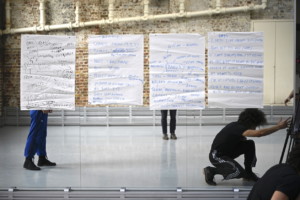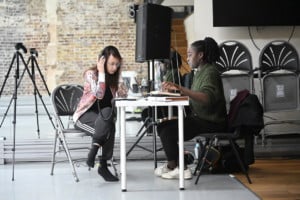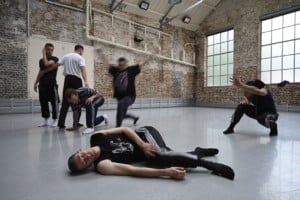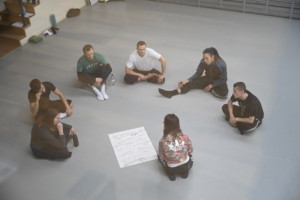Alumni spotlight: In conversation with Maxine Doyle
Wed 1 April 2020Dance maker Maxine Doyle completed her MA in Choreography at Trinity Laban (then the Laban Centre) in 1994 and has been Associate Director and Choreographer for Punchdrunk since 2002, having co-directed the multi-award winning Sleep No More among other productions.
She has also worked independently creating dance theatre work for companies including Martha Graham Company, Verve, Perth Festival and Johannes Wieland Company.
Most recently, Maxine has been collaborating with internationally acclaimed BalletBoyz and fellow Trinity Laban alum, composer Cassie Kinoshi on Deluxe, a show celebrating the company’s 20th anniversary.
We caught up with Maxine to find out more…
Tell us a bit about your creative process
“I think a lot, I research a lot. The piece lives with me. Before I begin a project I always do some writing – an ‘imagining’ – where I close my eyes and write what I see – images, words, stories – in a stream of consciousness. I then perhaps try and formalise that a bit more. Then I put it away and let the piece uncover itself and present itself. The challenge of not knowing where the process can take you is a kind of joy for me.
My work is very collaborative. It’s really about the movement language the dancers offer based on the tasks and frameworks I offer them. Part of my process is facilitating lots of skills and abilities in one space.”

(Image: Rehersal room mirros with notes credit George Piper)
How did you become involved with Deluxe?
“I had conversations with Michael [Nunn] and Billy [Trevitt, Artistic Directors] about doing work and originally it was only going to be a short 5 to 10-minute piece. After doing workshop with the dancers to see if our processes mixed, Michael and Billy then commissioned me to do a half hour piece and suggested I collaborate with a composer.”
Can you tell us a bit about your new work Bradley 4:18?
“I’ve been listening to English poet and spoken word artist Kate Tempest’s concept album Let Them Eat Chaos for the last few years. The album, set against a backdrop of global crisis and societal anxieties, describes the thoughts and feelings of several different characters as they struggle with their insomnia at 4:18 in the morning.
One poem-song, ‘Pictures on a screen’, became the shared starting point for my collaboration with the dancers and Cassie. The song’s character Bradley seemingly has everything – all the external markers of success like a great job and a riverside apartment – but feels super empty and questions his purpose in life. He asks himself whether he is awake or asleep and what he can do to get him out of his stupor. Bradley’s pre-occupations seem painfully relevant for the anxiety we’re feeling today.
In the dancework, the audience meets six different versions or facets of Bradley.”
(Image: BalletBoyz rehearsing Bradley 4:18 credit George Piper)
What was it like working with BalletBoyz?
“I recently made a piece on eight women for Martha Graham Company, working with composer and sound artist Leslie Flanaghan, but am generally used to bigger ensembles. So I asked myself ‘what did I want to explore with 6 male dancers? What’s our artistic conversation?’
BalletBoyz are famed for their beauty, grace and generally gorgeous dancing. I was interested in a different physicality and edge. I wanted to connect their theatricality to moving and had a desire to see the dancers as people in the piece. I was interested in how movement can be imbued with narrative, personality and project a heightened sense of self. I was interested in what dancers were offering me and how I could push or pull that.
I found the dancers really inspiring and hungry. They responded to a creative process that was different and challenging.”
(Image: BalletBoyz in rehearsal with Maxine credit George Piper)
What has it been like to collaborate with fellow TL alum Cassie Kinoshi?
The meeting point of music and dance language was really exciting. There was a sense that both elements can coexist but also have an independence to them.
I remember on the first day of my masters at Trinity Laban, going in and saying ‘I really want to collaborate with a composer’, so I have really enjoyed being given space and support to play with an artist from a different discipline.

(Image: Maxine and Cassie collaborating in the rehearsal studio credit George Piper)
It was an interesting process at the beginning. Michael and Billy sent me links to Cassie’s work – some for dance on film, something for Young Vic theatre, and the SEED Ensemble’s album Driftglass. I was really drawn to the diverse range of Cassie’s work. It seemed like she could shift between the orchestral, jazz ensemble and the cinematic. I’d also never worked with jazz music so was excited to see where I could direct this in relation to atmosphere and storytelling.
I believe the essence of a good collaboration is identifying taste, finding a common ground in aesthetic and appreciation. We would share film and visual references and music to give a sense of the atmosphere and tone we wanted to create. We talked a lot about atmosphere, tone, worlds; I felt like we understood each other very quickly in terms of what that meant. I wanted to create a sound-world that was dreamy but had a darkness to it, that was uncomfortable.
Cassie was in the studio with us a chunk of the time, to see how I work in terms of improvisation, working around a physical idea or the words. I was using lots of different types of music to change up the atmosphere and energy in the room. I would bring Angelo Badalamenti, Shostakovich, Philip Glass, Kylie Minogue. I didn’t want Cassie to be dictated to by my ideas. I wanted to offer jumping off points.
There were a couple of rehearsal where Cassie came in with her saxophone and recording gear and began to jam in response to choreographed phrases and images. This was exciting – a great energy and dialogue evolved organically.
We had a session with all ten musicians playing live with us. Having them there in terms of dynamic and dialogue was exciting. It gave a confidence to understand the potential of the piece. As the dancers began to work more specifically with the final, recorded musical work, the movement language became more nuanced.”
–
You can watch the digital version of Deluxe on Sadler’s Wells Facebook page until 2 April 2020 and will also feature in the BBC’s Culture in Quarantine festival.
Find out more about studying Dance at Trinity Laban.


